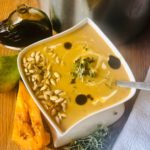Squash is available all year round but is mainly divided into winter and summer. Winter squash is so versatile – it can be used in a variety of ways, in soups and stews and can be a valuable cooking ingredient. Roasted squash is equally as tasty, as is cooking it and filling it with something delicious. Use it as a substitute for potatoes, it provides enough bulk and can help thicken up most sauces or soups. It provides good nutrition and is low in calories and not too bad in carbs. Protein delivers around 2% to help repair and build healthy cells.
Butternut Squash
Butternut squash is probably the most well-known of the variety with its ‘pear-shaped’ look, but it does have a thick skin which can be difficult to peel easily. Fight your way through the peeling process, as what is beneath is well worth the effort. Most people are surprised that they grow on a vine and when ready to pick, are usually anywhere between a deep yellow and a bright orange. Economical to buy in the UK, which is different to most vegetables along with other pulses, as it is relatively easy to grow. In India, it is widely used in curries, which are particularly flavourful and freeze easily, either frozen or raw.
 |
Hankering a taste for Butternut squash soup?
|
Acorn Squash
Acorn squash is also found here, but not so readily as its best friend, the butternut. This is probably because it is only harvested in autumn, so doesn’t have the length of availability in UK shops. Interesting, the taste is different – it is sweeter and nuttier and can be found in different shapes as opposed to simply round. It tends to be green but sometimes with a yellow or orange ‘splodge’. Nutrition value is high, plenty of omega-3 fats and fibre, both beneficial to a healthy diet. A chef I know, uses it in a form of pumpkin pie, as they are definitely sweeter than other types of squash.
There are plenty of squash competitions, but no real festivals or national days. But farmers do get involved in largest, most colourful, odd shape and beautiful’, in village fetes up and down the UK. It really is a quaint little tradition and brings different communities together. Besides which, you can enjoy an afternoon cream tea to boot!
How to Buy Squash
When deciding which squash to buy, pick one or two that have smooth, unblemished skin. All squash feels heavy, so don’t be put off by that, and don’t go for the bright orange ones, just because your eyes are attracted to them. Smooth-ish skin is much more important.
Easiest Ways to Prepare Squash
Do you know the best and easiest way to prepare squash? A lot of people are put off from using squash as it can be tricky. It can often slip and slide on your worktop if you don’t get a firm grip on it, causing some nasty cuts with the sharp knife you must use to cut through the tough outer skin. Here is the best way to cut it:
Cutting the squash
Place a damp tea towel on to your work surface. Put your board on the top. Grip firmly with one hand and firmly cut down across the middle. If it really is too hard, cover the knife and squash with another tea towel and hit the back of the knife with something heavy to split it down the centre.
Peeling the squash
Depending on the shape, either support it on its side with your hand or sit it flat on the board. Use a sharp vegetable peeler or sharp knife to peel off the skin. If you’re roasting large segments, it’s easier to remove the skin after cooking. You don’t need to worry about squashes with softer skin – it gets even softer with cooking. Cut in half or quarters.
Removing the seeds
Take a large spoon and scoop out the seeds and stringy bits. Yippee! Ready to cut into cubes or slices for roasting. If you are not going to use it there and then, place in damp plastic bags and it will keep for over a week in the fridge. Otherwise, freeze it.
Most hard-skinned squash can be stored whole in a dark place, and they will last for 2 or even 3 months.
Make the most of squash in the autumn and winter, particularly soups, as you can achieve a great texture. I love roasted squash, particularly in a tray with lots of other vegetables and cooked in olive oil. Saves time and washing up!


Want to comment?
Sign in or Register